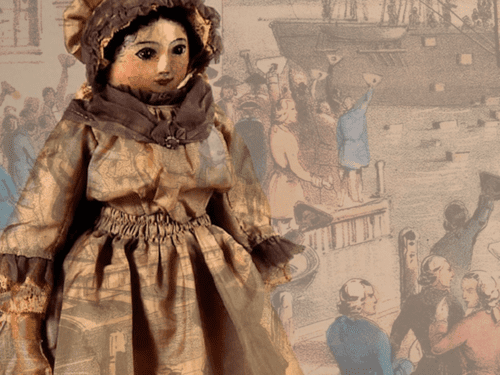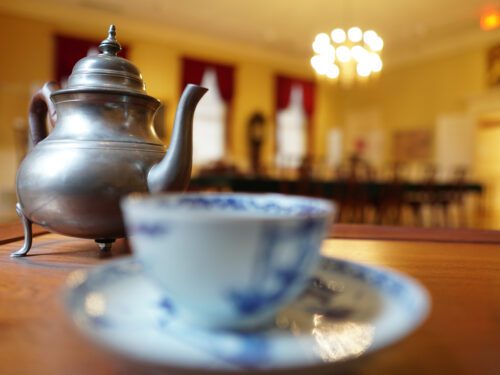Polly Sumner
Witness to the Boston Tea Party Book Launch
Registration for this program is now closed.

Can a fashion doll from England find friendship and happiness in colonial America? Revolutionary Spaces is honored to host the Polly Sumner: Witness to the Boston Tea Party Book Launch on Wednesday, April 19 at the Old South Meeting House.
Author Richard C. Wiggin will read excerpts from his new children’s book, which tells the story of Polly Sumner, a real doll that arrived in Boston aboard one of the Tea Party ships 250 years ago. Beautifully illustrated by local artist/illustrator Keith Favazza, this book is both a heartwarming tale and an educational primer for kids. Following the reading, Revolutionary Spaces will host a panel discussion with Wiggin, Favazza, historian Dr. Robert Allison, and author Vivian Kirkfield. Guests will also have the opportunity to purchase a copy of Polly Sumner: Witness to the Boston Tea Party and have their book signed by the author.
While at this program, view a stunning reproduction of the Polly Sumner doll, made possible through the generous support of Richard C. Wiggin and Agnes Connors. On display for a limited time starting in April 2023, the Polly Sumner doll can tell her stories just in time for the 250th anniversary of the Boston Tea Party! Associate Director of Collections Lori Erickson will be on hand to talk with guests about the reproduction and original doll, which is currently part of Revolutionary Spaces’ expansive collection. A letter-writing station will also be available for guests to send fan mail to Polly Sumner.
This program is free and open to the public. Doors will open at 6:00 pm and the reading will begin at 6:30 pm. A station with light snacks, cookies, and “Polly Punch” will be provided. For more information about Polly Sumner: Witness to the Boston Tea Party, visit: www.pollysumner.com.
About the Participants
Richard C. Wiggin is a historian, former Executive Director of The Bostonian Society (now Revolutionary Spaces), and former Captain and Historian of the Lincoln Minute Men. His award-winning book, Embattled Farmers: Campaigns and Profiles of Revolutionary Soldiers from Lincoln, Massachusetts, 1775-1783 (Lincoln Historical Society, 2013), chronicles the American Revolution through the experiences of 256 soldiers from a single New England farming community. As a living historian and battlefield volunteer at Minute Man National Historical Park, Wiggin appears regularly in school classrooms and enjoys speaking before civic and historical groups. He has organized and conducted scores of public ceremonies and written audio tours for Minute Man National Historical Park and Boston’s Freedom Trail. His articles have appeared in Alaska Magazine, The Boston Globe, Civil War Courier, The Lincoln Review, and American Ancestors.
Keith Favazza has created countless illustrations for many of the world’s leading publishing houses. In creating the drawings for this book, he walked where the early American Patriots walked, studied eighteenth-century life, and climbed on board a replica of a Boston Tea Party ship. Minutes away from Griffin’s Wharf, where Polly arrived, is another wharf where Keith’s grandfather captained his fishing vessel in Boston’s North End. Keith lives in historic Plymouth, a vibrant coastal town where many of his public art pieces can be found on the waterfront. He has a passion for gardening, cooking, and of course, drawing.
Robert J. Allison is a professor of history at Suffolk University. His books include The Crescent Obscured: The United States and the Muslim World, a biography of American naval hero Stephen Decatur, and short books on the history of Boston, the American Revolution, and an edition of The Interesting Narrative of Olaudah Equiano, or Gustavus Vassa, the African. Two of his classes, “Before 1776: Life in Colonial America,” and “The Age of Benjamin Franklin” are available from The Great Courses. As chair of Revolution 250, a consortium of organizations planning Revolutionary commemorations in Massachusetts, he hosts its weekly podcast featuring conversations on the Revolution with historians and interpreters. He is President of the Colonial Society of Massachusetts, a scholarly organization focused on early American history, and a life-trustee of the USS Constitution Museum.
Vivian Kirkfield is a writer for children—reader forever. Her bucket list contains many more words—but she’s already checked off skydiving, walking under the ocean, and circumnavigating the globe. When she isn’t looking for ways to fall from the sky or sink under the water, she can be found writing books in the picturesque town of Bedford, New Hampshire. A retired kindergarten teacher with a masters in Early Childhood Education, Kirkfield inspires budding writers during classroom visits and shares insights with aspiring authors at conferences and on her blog where she hosts the #50PreciousWords International Writing Contest and the #50PreciousWordsforKids Challenge. Her nonfiction narratives, including Sweet Dreams, Sarah: From Slavery to Inventor; Making Their Voices Heard: The Inspiring Friendship of Ella Fitzgerald and Marilyn Monroe; and From Here to There: Inventions That Changed the Way the World Moves, bring history alive for young readers and have garnered starred reviews and accolades including the Silver Eureka, Social Studies Notable Trade Book, and NSTA Best STEM Book K-12. Visit her at viviankirkfield.com.

Boston Tea Party 250th Anniversary
This year, Revolutionary Spaces is commemorating the 250th anniversary of the Boston Tea Party, which took place at Old South Meeting House on December 16, 1773. This public program is made possible through the generous support of our Boston Tea Party 250th Anniversary Commemoration Transformational Partner: Meet Boston Foundation.

